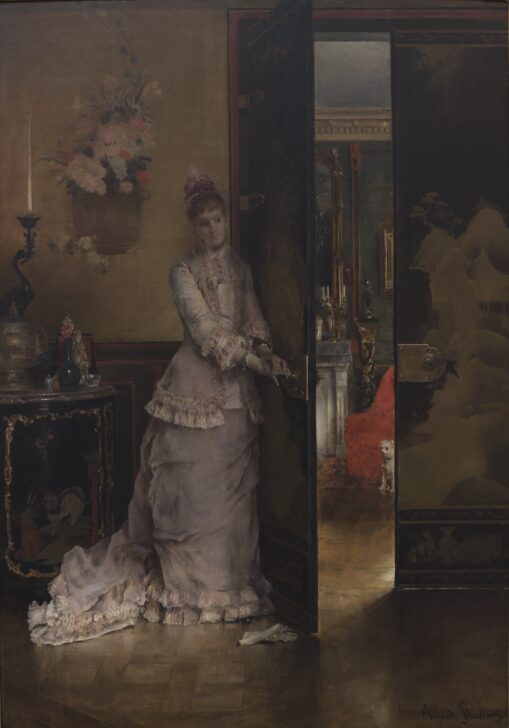Hide and Seek (Cache-Cache)
Alfred Stevens

Description
Alfred Stevens
Belgium, 1823-1906
Hide and Seek (Cache-Cache)
ca. 1878
Oil on panel
Bequest of Margaret Watson Parker, 1955/1.85
In Western art, the use of motifs culled from the art of China, and
anywhere east of the Mediterranean and west of Japan, is known as
chinoiserie. This painting exemplifies the European fascination with
chinoiserie, which became an international design aesthetic in the
eighteenth and nineteenth centuries. It depicts luxurious East Asian
ceramics, including a blue and white ware, and lacquered furniture.
Another popular motif in the genre was Chinese embroidered
tapestry—a similar textile is on display in the adjacent case. These
objects were used to represent as exotic and distant the cultures
over which Europe and the United States had colonial ambitions.
Fall 2022 Gallery Rotation
__________
Alfred Stevens
Belgium, 1823–1906
Hide and Seek (Cache-Cache)
ca. 1878
Oil on panel
Bequest of Margaret Watson Parker, 1955/1.85
In Western art, use of motifs culled from the art of China, and
anywhere east of the Mediterranean and west of Japan, in Western
art is known as chinoiserie. This painting exemplifies the European
fascination with chinoiserie, which became an international design
aesthetic in the eighteenth and nineteenth centuries. It depicts
luxurious East Asian blue and white wares, blue and white wares made
by Europeans, and a Chinese embroidered tapestry—a similar textile
is on display in the adjacent case (3). Such wares were often used to
represent as exotic and distant the cultures over which Europe and
America had colonial ambitions.
Summer 2022 Gallery Rotation
__________
March 28 2009
Alfred Stevens was a Belgian artist active in Paris who specialized in paintings of women in sumptuous surroundings; he frequently depicted the trials and disappointments of courtship in elegant society. The setting of Hide and Seek is Stevens’s own house in Paris, which was furnished with exotic lacquered doors and other luxurious items reputedly from the imperial palace in Beijing; these are characteristic of the taste for Chinese and Japanese art in fashionable circles at the time.
X-ray examination has revealed that Stevens experimented with the subject and composition of the painting. It seems he first painted a young girl standing in the doorway; she was subsequently painted over and replaced with a dog. With careful observation, the girl with her wide skirt is still discernable. The substitution of a dog for the girl, along with the woman’s absorbed expression and the glove dropped carelessly on the floor, suggest an intriguing narrative: the dog may be looking at a suitor in the next room with whom the woman is playing a game of hide and seek. In the tradition of seventeenth-century Dutch interior scenes, often used as models by nineteenth-century French painters, the playing of parlor games suggests a scene of seduction and reveals the painting’s erotic subtext.
Subject Matter:
The setting for “Cache-cache” is Stevens’ own Parisian house on the Rue de Martyrs. X-ray examination revealed that he first painted a young girl standing in the doorway, with whom the game of hide and seek is being played. She was subsequently painted over and a dog was painted in her stead, which enabled Stevens to concentrate on the perspective into the room beyond, the glove on the floor (indicating the haste with which the lady has entered the room), and it diminishes the potential human interest of the scene allowing the viewer to focus more fully on the beautiful rendering of objects and surfaces. The real subject of this painting therefore, is Stevens’ study of decorative objects and costumes and the play of light on their various surfaces, textures, and colors.
Physical Description:
Panel painting depicting a young woman of high society in an interior setting filled with Asian accessories. She stands behind a door, which she holds partly open revealing a small white dog sitting in front of an armchair.
Usage Rights:
If you are interested in using an image for a publication, please visit https://umma.umich.edu/request-image/ for more information and to fill out the online Image Rights and Reproductions Request Form.